Choosing a Gaming CPU: Single + Multi-GPU at 1440p, April 2013
by Ian Cutress on May 8, 2013 10:00 AM ESTCPU Benchmarks
Point Calculations - 3D Movement Algorithm Test
The algorithms in 3DPM employ both uniform random number generation or normal distribution random number generation, and vary in amounts of trigonometric operations, conditional statements, generation and rejection, fused operations, etc. The benchmark runs through six algorithms for a specified number of particles and steps, and calculates the speed of each algorithm, then sums them all for a final score. This is an example of a real world situation that a computational scientist may find themselves in, rather than a pure synthetic benchmark. The benchmark is also parallel between particles simulated, and we test the single threaded performance as well as the multi-threaded performance.
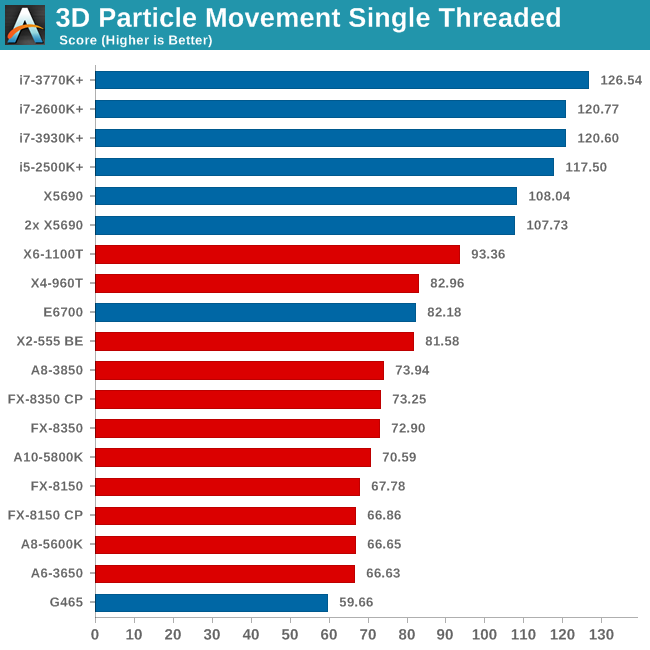
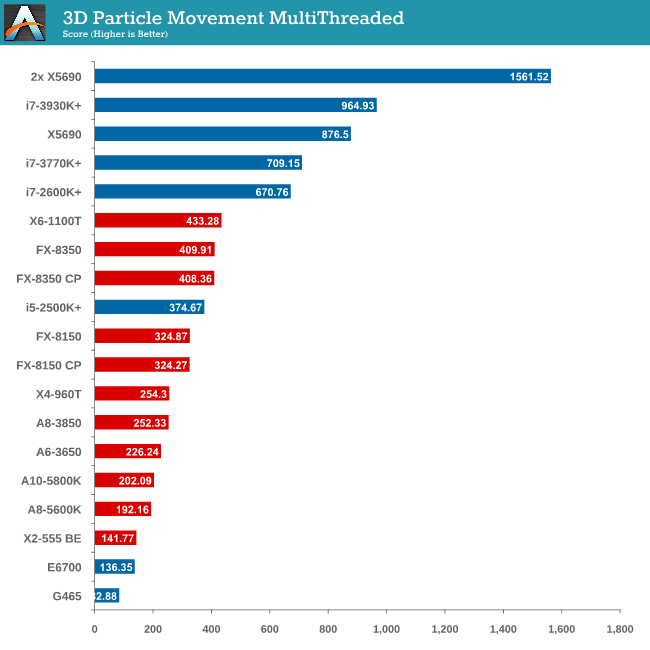
As mentioned in previous reviews, this benchmark is written how most people would tackle the situation – using floating point numbers. This is also where Intel excels, compared to AMD’s decision to move more towards INT ops (such as hashing), which is typically linked to optimized code or normal OS behavior.
Compression - WinRAR x64 3.93 + WinRAR 4.2
With 64-bit WinRAR, we compress the set of files used in our motherboard USB speed tests. WinRAR x64 3.93 attempts to use multithreading when possible and provides a good test for when a system has variable threaded load. WinRAR 4.2 does this a lot better! If a system has multiple speeds to invoke at different loading, the switching between those speeds will determine how well the system will do.
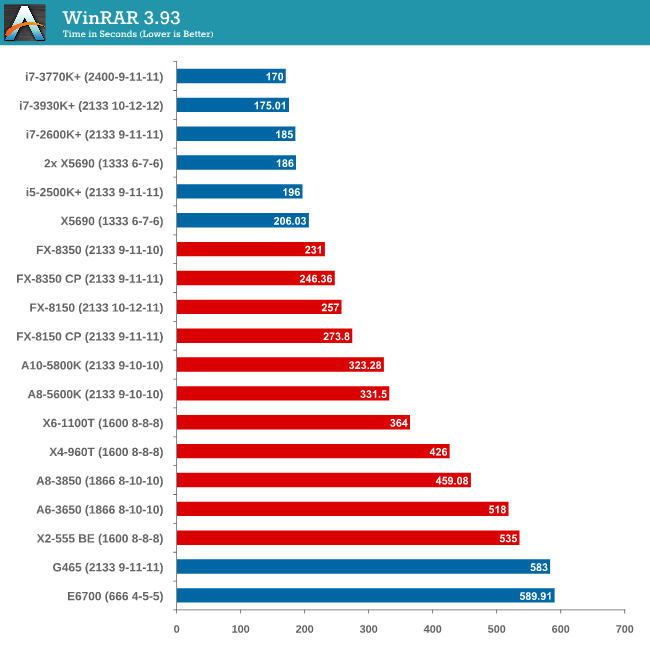

Due to the late inclusion of 4.2, our results list for it is a little smaller than I would have hoped. But it is interesting to note that with the Core Parking updates, an FX-8350 overtakes an i5-2500K with MCT.
Image Manipulation - FastStone Image Viewer 4.2
FastStone Image Viewer is a free piece of software I have been using for quite a few years now. It allows quick viewing of flat images, as well as resizing, changing color depth, adding simple text or simple filters. It also has a bulk image conversion tool, which we use here. The software currently operates only in single-thread mode, which should change in later versions of the software. For this test, we convert a series of 170 files, of various resolutions, dimensions and types (of a total size of 163MB), all to the .gif format of 640x480 dimensions.
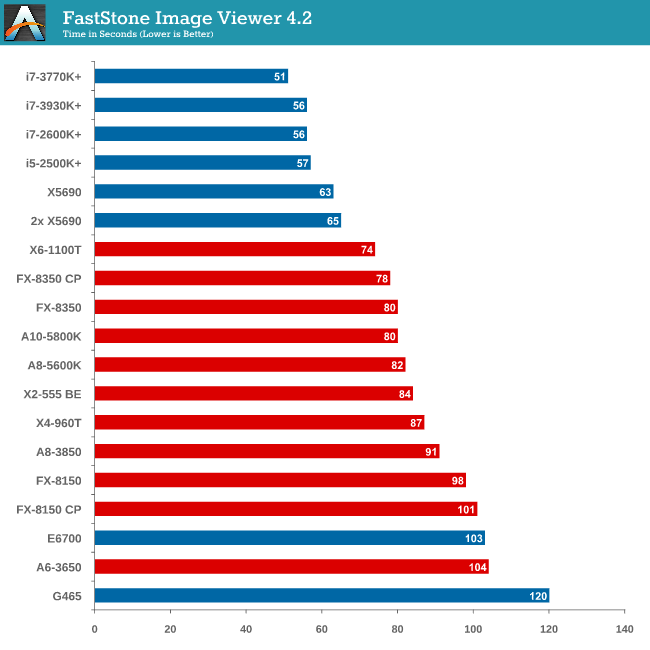
In terms of pure single thread speed, it is worth noting the X6-1100T is leading the AMD pack.
Video Conversion - Xilisoft Video Converter 7
With XVC, users can convert any type of normal video to any compatible format for smartphones, tablets and other devices. By default, it uses all available threads on the system, and in the presence of appropriate graphics cards, can utilize CUDA for NVIDIA GPUs as well as AMD WinAPP for AMD GPUs. For this test, we use a set of 33 HD videos, each lasting 30 seconds, and convert them from 1080p to an iPod H.264 video format using just the CPU. The time taken to convert these videos gives us our result.
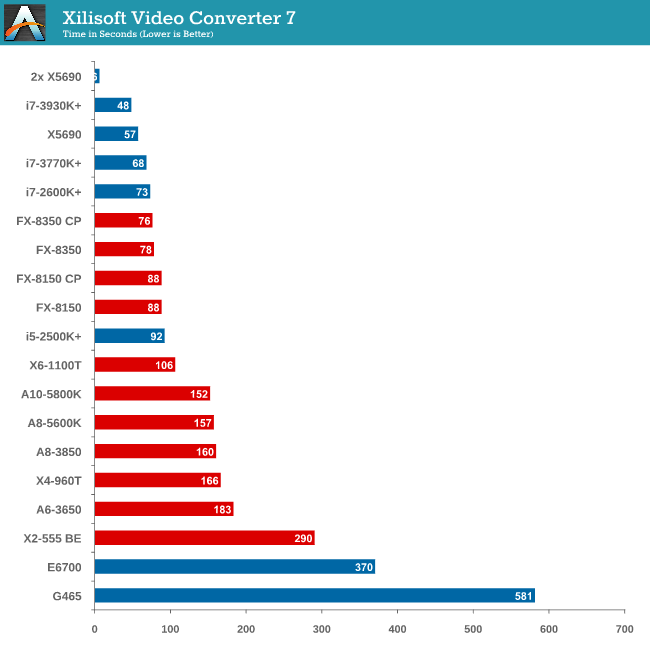
XVC is a little odd in how it arranges its multicore processing. For our set of 33 videos, it will arrange them in batches of threads – so if we take the 8 thread FX-8350, it will arrange the videos into 4 batches of 8, and then a fifth batch of one. That final batch will only have one thread assigned to it (!), and will not get a full 8 threads worth of power. This is also why the 2x X5690 finishes in 6 seconds but the normal X5690 takes longer – you would expect a halving of time moving to two CPUs but XVC arranges the batches such that there is always one at the end that only gets a single thread.
Rendering – PovRay 3.7
The Persistence of Vision RayTracer, or PovRay, is a freeware package for as the name suggests, ray tracing. It is a pure renderer, rather than modeling software, but the latest beta version contains a handy benchmark for stressing all processing threads on a platform. We have been using this test in motherboard reviews to test memory stability at various CPU speeds to good effect – if it passes the test, the IMC in the CPU is stable for a given CPU speed. As a CPU test, it runs for approximately 2-3 minutes on high end platforms.
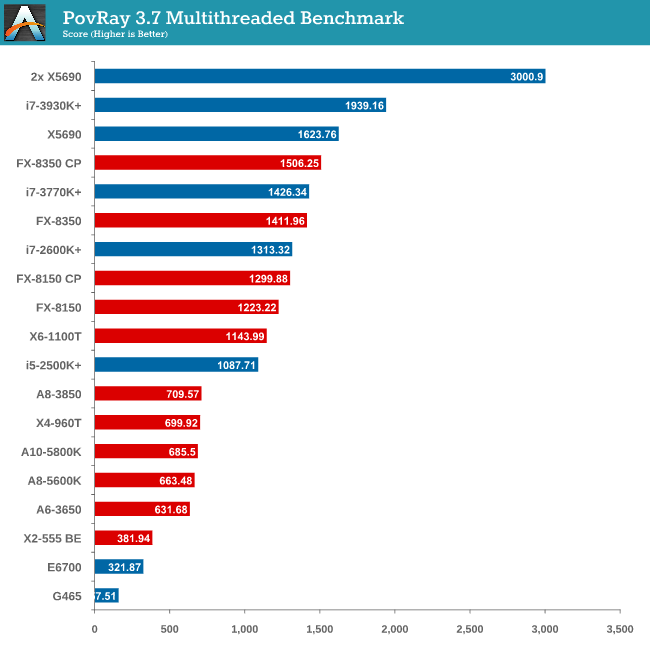
The SMP engine in PovRay is not perfect, though scaling up in CPUs gives almost a 2x effect. The results from this test are great – here we see an FX-8350 CPU below an i7-3770K (with MCT), until the Core Parking updates are applied, meaning the FX-8350 performs better!
Video Conversion - x264 HD Benchmark
The x264 HD Benchmark uses a common HD encoding tool to process an HD MPEG2 source at 1280x720 at 3963 Kbps. This test represents a standardized result which can be compared across other reviews, and is dependent on both CPU power and memory speed. The benchmark performs a 2-pass encode, and the results shown are the average of each pass performed four times.
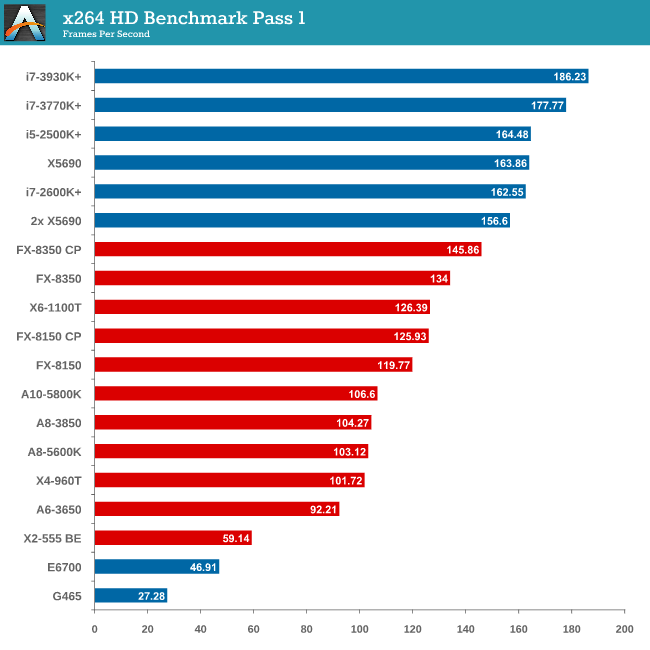
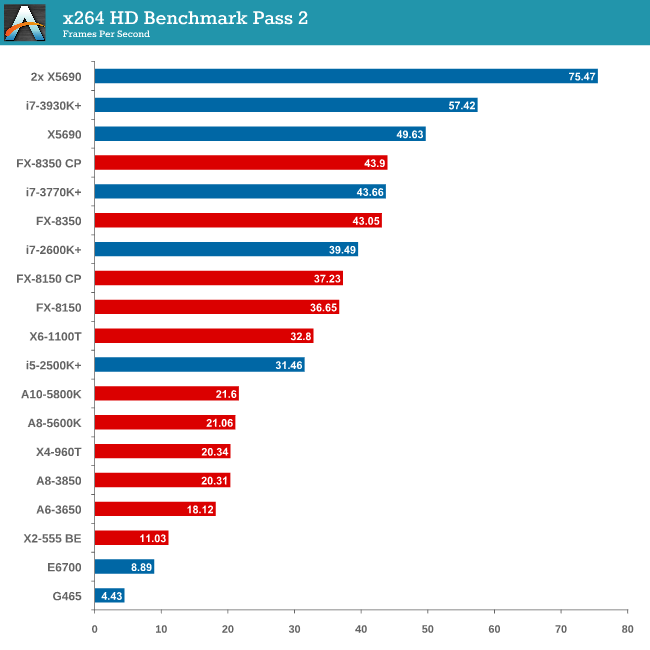
Grid Solvers - Explicit Finite Difference
For any grid of regular nodes, the simplest way to calculate the next time step is to use the values of those around it. This makes for easy mathematics and parallel simulation, as each node calculated is only dependent on the previous time step, not the nodes around it on the current calculated time step. By choosing a regular grid, we reduce the levels of memory access required for irregular grids. We test both 2D and 3D explicit finite difference simulations with 2n nodes in each dimension, using OpenMP as the threading operator in single precision. The grid is isotropic and the boundary conditions are sinks. Values are floating point, with memory cache sizes and speeds playing a part in the overall score.
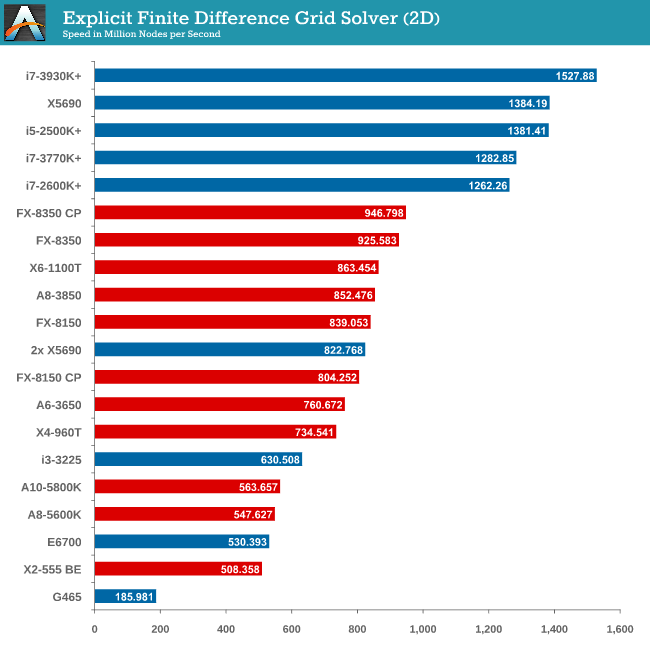
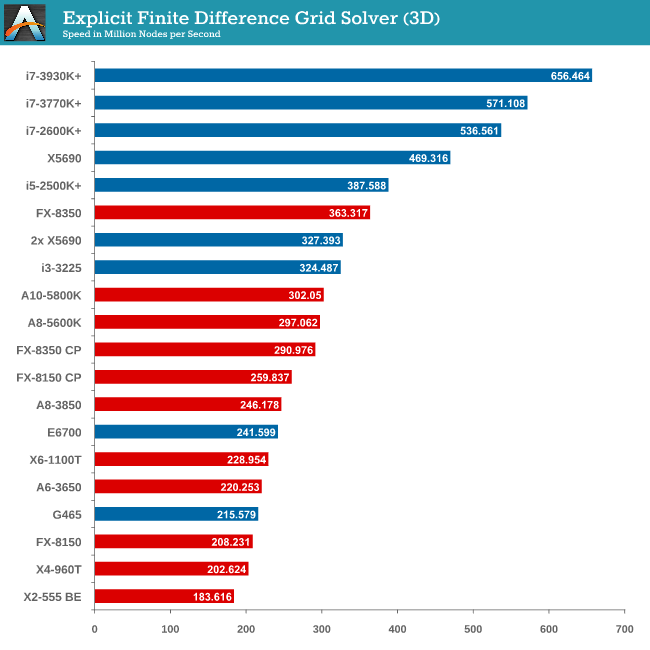
Grid solvers do love a fast processor and plenty of cache in order to store data. When moving up to 3D, it is harder to keep that data within the CPU and spending extra time coding in batches can help throughput. Our simulation takes a very naïve approach in code, using simple operations.
Grid Solvers - Implicit Finite Difference + Alternating Direction Implicit Method
The implicit method takes a different approach to the explicit method – instead of considering one unknown in the new time step to be calculated from known elements in the previous time step, we consider that an old point can influence several new points by way of simultaneous equations. This adds to the complexity of the simulation – the grid of nodes is solved as a series of rows and columns rather than points, reducing the parallel nature of the simulation by a dimension and drastically increasing the memory requirements of each thread. The upside, as noted above, is the less stringent stability rules related to time steps and grid spacing. For this we simulate a 2D grid of 2n nodes in each dimension, using OpenMP in single precision. Again our grid is isotropic with the boundaries acting as sinks. Values are floating point, with memory cache sizes and speeds playing a part in the overall score.
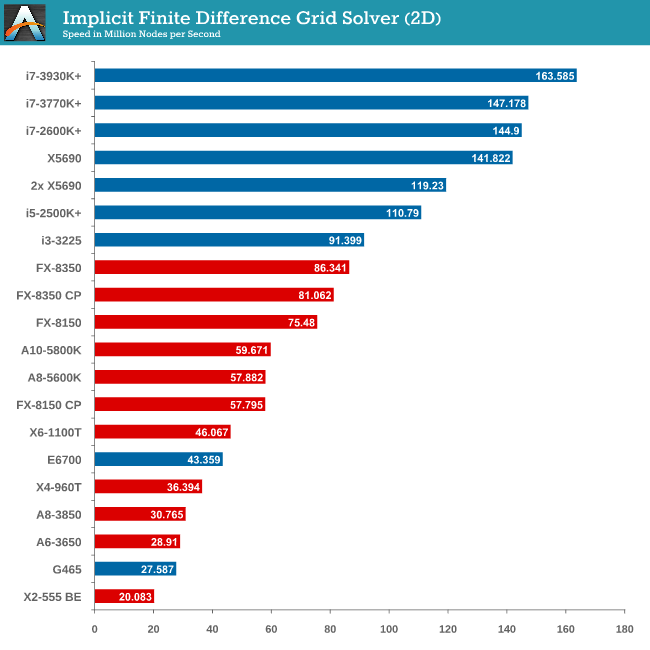
2D Implicit is harsher than an Explicit calculation – each thread needs more a lot memory, which only ever grows as the size of the simulation increases.
Point Calculations - n-Body Simulation
When a series of heavy mass elements are in space, they interact with each other through the force of gravity. Thus when a star cluster forms, the interaction of every large mass with every other large mass defines the speed at which these elements approach each other. When dealing with millions and billions of stars on such a large scale, the movement of each of these stars can be simulated through the physical theorems that describe the interactions. The benchmark detects whether the processor is SSE2 or SSE4 capable, and implements the relative code. We run a simulation of 10240 particles of equal mass - the output for this code is in terms of GFLOPs, and the result recorded was the peak GFLOPs value.
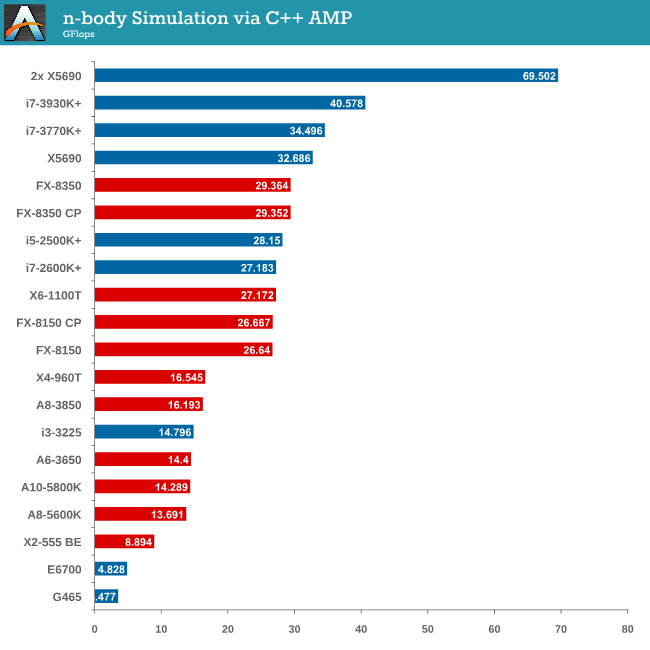
As we only look at base/SSE2/SSE4 depending on the processor (auto-detection), we don’t see full AVX numbers in terms of FLOPs.










242 Comments
View All Comments
HisDivineOrder - Thursday, May 9, 2013 - link
Shhhhhh. You're using too much of that stuff called sense. It might spread and suddenly everyone would want case reviews that reflect what anyone who'd install a motherboard in 99% of the cases they review instead of miniITX for every review. I mean, there's no way that putting a miniITX or microATX into every case review isn't going to impact the actual case being reviewed, is there?IS THERE?
crimson117 - Thursday, May 9, 2013 - link
Agreed - why review a full tower with a micro atx? Who builds like that?Gigaplex - Sunday, May 12, 2013 - link
I do. Is that a problem?Blibbax - Wednesday, May 8, 2013 - link
If you're recommending the A8-5600K, but for people with a discrete GPU, aren't you really recommending the FX-4*** series?Ortanon - Wednesday, May 8, 2013 - link
Excellent question.IanCutress - Wednesday, May 8, 2013 - link
Good point - apart from not testing the FX-4xxx processors (I don't have any), the FX-4xxx uses an AM3 platform - the FM2 platform is both newer and the chipsets offer more native USB 3.0 / SATA 6 Gbps as well as a UEFI BIOS from the ground up. The FX-4xxx is still a relevant choice with its L3 cache, and a couple of newer boards have been released to try and get the best from the 990FX chipset. Though out of what I have tested so far, the A8 makes the most sense if you're looking at pure 1-GPU gaming. If I get an FX-4100 in, it will be tested and conclusions adjusted if it performs similarly - there's no point suggesting a CPU I haven't tested and can't back it up with data.Ian
Blibbax - Wednesday, May 8, 2013 - link
I entirely agree that it'd be wrong to make conclusions without data. However, I feel like the APU recommendation ought to go with some sort of "however..." caveat.I look forward to your FX4 and FX6 results, however. I was initially not at all sold on these chips, but now that the prices have come down and the FX6 is often priced against Intel's i3, they are much more compelling.
DeathReborn - Wednesday, May 8, 2013 - link
There's always the Athlon II X4 750K BE which still uses FM2 but lacks the IGP.Cow86 - Wednesday, May 8, 2013 - link
If you're going to compare it against Trinity APU's, then wouldn't it be fairer to get an FX-4300, based on the same piledriver core? See if that L3 cache makes enough of a difference? More up to date as well...kmmatney - Wednesday, May 8, 2013 - link
If you live near a microcenter, you can get an FX-4130 (3.8 Ghz) and motherboard for $99. That leaves quite of room to get a better GPU, and probably a better overall gaming experience for a given amount of money. I upgraded from an X4-955 to a 3570K about 6 months ago, and have to admit that I barely notice the performance increase in games, and would have probably been better off spending the $250 on a better video card. I do like the extra speed while using handbrake, though, and my son likes my old X4-955 that was a big upgrade from his previous setup, though.